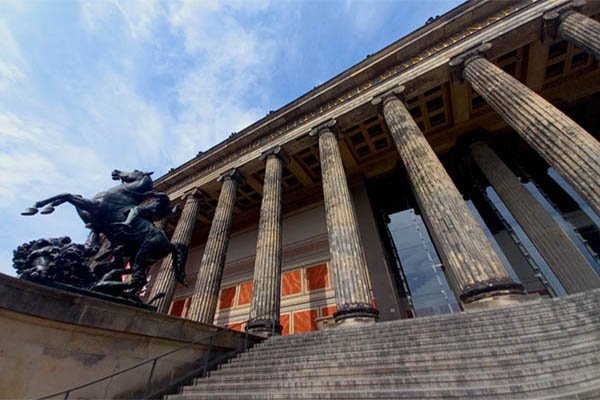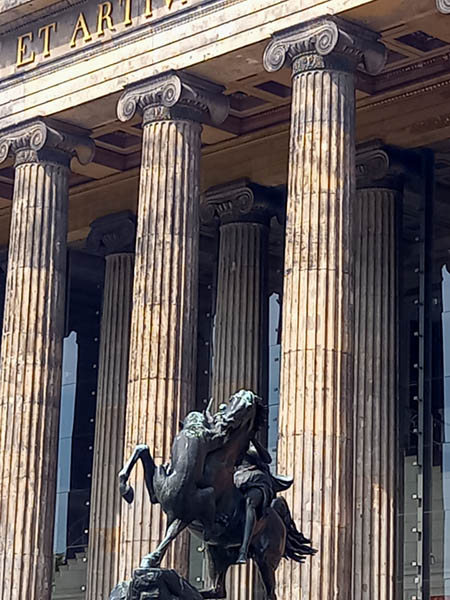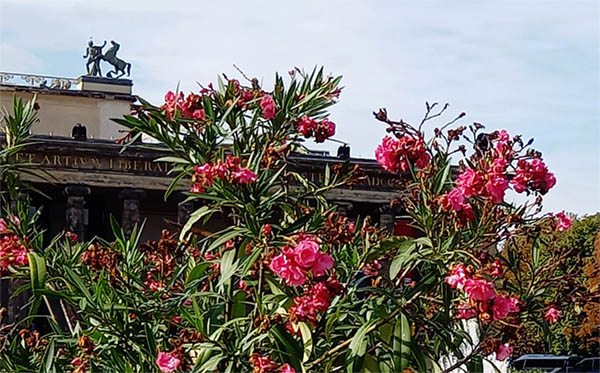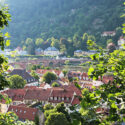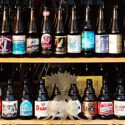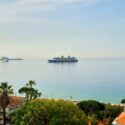The timeline of the Altes museum tells a story that piques my interest as much as the Greek, Etruscan and Roman sculptures that are on display inside the museum. This building has been around and seen a lot. The expression ‘if only walls could talk’, sums it up very suitably. The Greek exhibition is on the ground floor and the Etruscan and Roman exhibitions are on the first floor. This is symbolic in a way, since much of what the Roman sculptures was about built on knowledge passed on by the Greeks. I’m greeted by not one, but two rows of Hoplite helmets and with that as a welcoming I stride to the sculptures that rise towards the ceiling.
Accumulation of art in modern times
Dates on the plaques tell of when and how these works of art were acquired. The 19th century as well must have been hectic periods for archaeologists and colonialists, when they hurried off with huge stone and marble works of art from the south of Europe to all over (usually the north of Europe, and later across the Atlantic). As I enjoy the ease with which I can walk around and gaze at busts, helmets, and old sarchophagi, my mind drifts to the last few hundred years when this art was uprooted from different places, often by an aristocrat or some self-labelled benevolent art lover. Set against the times of the 19th century and that of the 1930s, when Europe was full of fervent activity, just imagine all the hands that have carried, handled and studied this art. First, I recognize the activity in the last two centuries. But we can go back much further, all the way to the 7th and 6th centuries BC. It is jawdropping to realize the times that have come and have gone and how these pieces of art cut in stone and marble have survived. So many people in different eras and inscriptions on tablets and small details on metal helmets that have endured beyond the lifespans of many human generations.
“In our time we may say that all roads lead to Rome, but back then Etruscans knew it as Ruma and it was not a member town of the most important Etruscan leagues”
Going back, let’s pick a date
If we were to pick a time, let’s say an era, to stop our imagination from running wild – Let’s go for the Etruscan times on the Italian peninsula. The Etruscans were the precursor to the Romans on that peninsula and when they had expanded they stretched from the Alps to well south of Rome
In our time we may say that all roads lead to Rome, but back then Etruscans knew it as Ruma and it was not a member town of the most important Etruscan leagues (confederations of towns, usually 12). Back then, the so-called leagues, or Dodecapolis, had no fixed set of member towns. The member towns fluctuated and there was not one capital, instead the cities were autonomous states, with the largest roughly 25,000 to 40,000 inhabitants around the 6th century B.C. That’s plenty of numbers there. Suffice to say, that in the age of the Etruscans, there was not one capital but instead 12 cities grouped together termed Dodecapolis. The largest Dodecapolis in the age of the Etruscans did not include what we know as Rome, which was called Ruma by the Etruscans.
The Etruscans expanded across the channel to what we know as Corsica, and north to the Alps. Now consider twelve cities in the largest Dodecapolis, and if we lowball their populations at 25,000 each, we end up with 300 000 people in the largest Etruscan league. That is a lot of people socializing, creating social structures and hierarchies, building and maintaining art, and passing on language over the generations. This is at the cusp of the beginning of the classical antiquity centered on the Mediterranean Sea, and the so-called Greco-Roman world.
This mind experiment does the following: Take roughly two thousand years of cultures, city states, and later countries come and go. Consider our contemporary reference points, loan words from “classical languages” as well as sculptures, such as these in the Altes museum. Then ask yourself, how could things have gone differently? Yeah, that’s a pretty open ended question, right there. But as we fast forward into our time and plunk ourselves down right here in the Altes museum in the year of 2023, what we see is Etruscan, and then the Greek and Roman cultural and political manifestation in solid objects such as sculptures. These are stories of life and these are stories of organized efforts to document and immortalize life.
Classical antiquity, the label
In a way, modern European civilization begins with this time period as a reference point. Usually there will be teachings about how culture and science can trace their roots back to the texts written in these times. We call it the classical antiquity. Why? Because Renaissance writers saw a need to label and distinguish those times from the medieval times. Wait. Again. In the Renaissance there were thinkers who decided that it was necessary to trace back human activity to a time period – A time period where human effort had created lasting art, ideas, and knowledge that was still living on in Renaissance times. The time as we know by its label was considered to be a rebirth of civilization. Take a bit there, and a bit here, sprinkle new ideas and grand visions on top and you have the Renaissance and what comes after.
Classical antiquity as a concept
So the notion of classical antiquity has served as a reference point from the Renaissance and onward. It was and it is a baseline, from which (some) cultures inherit ideas. My eyes fall on a sculpture of a mourning female servant. She is resting her head in her cupped hand, her arm supported on her leg as she sits there. Her gaze looks slightly up and away, and it is clear she isn’t altogether happy with her situation. I would wager sure she didn’t have time or energy to think much about the societal and geographical world she was in, which was around 330 – 320 B.C. Because quite frankly, she hadn’t seen the impact of the classical antiquity to come some two thousand years later. She did not know of anything more modern than the world she lived in. In fact she didn’t know about the term classical antiquity because she was living in it and it was as real as it gets, there was nothing antique about it. The labelling wasn’t required until more than two thousand years later.
Again I gaze at her look of heavy contemplation. “What if we don’t consider classical antiquity, indeed?” and my sneakers squeak loudly in this large room full of sculptures as I make a quick turn to walk down the hall.
If classical antiquity in itself is a framework, it sure was not that classical say, in the year 800 B.C. It would have been great forward-thinking, art and scientific ideas still waiting to become a thought in someone’s mind, and bear fruit such as architecture, sculptures, language, and organization of things and people.
The evolving of art and science contains plenty of borrowed and altered ideas and real concrete inventions. Take the portrait bust of Pericles in the Altes museum. The original was a piece of marble from Roman times, around 430 BC. But the one that we see in the museum is a copy. The original stood on the Athenian Acropolis. But it’s not just that actual material piece of art, there is the idea of the idealised portrait with Pericles wearing a Corinthian helmet as a portrait type. At the time in the fifth century BC this was typical for Athenian officers. And so the idea lives on in a copy to convey the contextual reality to us here in the twentyfirst century.
Anyhow. My sneakers continue making annoying rubbery sounds as I turn here, and then there, my attention being drawn in all directions. So I find myself in front of a row of mummy portraits from Egypt. These mummy portraits from Egypt made by Roman soldiers and locals may be the best glimpse of the facial features of people back then. A collection of some 300 portraits were found and dated to before the third century AD. The portraits were found in 1887 by a Viennese merchant as he traveled in Fayrum (recall the busy 1800s with acquiring art). Fayrum was an oasis some 70 km from Cairo. The portraits show men and women usually in their thirties, according to research, and I muse as this could very well be an example of an early way of getting your snapshot done (slowly, slowly) as there are indications that these were not made only for grave ornaments but also for decorations at home. But in ancient times, they weren’t created by pressing a camera shutter. No, back then it required a meticulous combination of bee’s wax with brine, mixed with mineral paints to create some astonishing portraits that took plenty of time to create. Imagine someone in the third century AD saying ““I’ll just hang my portrait here above my curule chair, next to the robe and Gladius and Galea.” The phrase may sound oddly malplaced in time, but why not. The result is admirable, with rich shades of color and an almost impressionistic style thanks to the shine effect produced by the wax.
“I’ll just hang my portrait here above my curule chair, next to the robe and Gladius and Galea.”
As I leave the museum I sit down on the stone steps by a row of imposing columns at the entrance. And I just gaze at the open area stretching out on the Berlin museum island. A short moment of peace in mind, tranquility beckoned by a sense of humility. I recall my earlier question, “how could things have gone differently?”. I realize at that moment that it matters little, because it happened the way it happened. And my other question “What if we don’t consider classical antiquity, indeed?” finds its answer in that classical antiquity, the time, the label, artistic activities – It all shaped a lot of what I see in front of me and around me.
Appreciation of this art installation is in order, for the world we call classical antiquity has left some remarkable art that indeed invigorate the mind.
More inspiration for exploring Germany
Check this out on your trip by train or car through Hesse and Baden-Württemberg in Germany.
Aachen and a visit to Monschau in nearby Eifel.
By Paul-Christian Markovski, freelance writer, EuropeZigZag.com.
